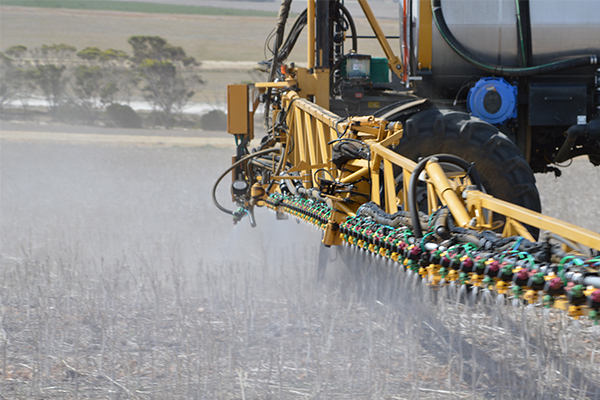To simplify the decision and reduce the range of options when selecting adjuvants for post-emergent use, let’s discuss the important things to consider.

Mixing adjuvants
Generally, when the majority of products listed on the adjuvant label are non-selective herbicides like glyphosate and paraquat-based products, the adjuvant is probably intended for pre-emergent use. A notable exception to this is herbicide tolerant crops such as glyphosate or glufosinate-tolerant varieties.
Conversely, a label recommendation to use the adjuvant with selective herbicides, insecticides, fungicides and desiccants is usually indicative of a post-emergent use pattern.
The range of adjuvant attributes required
Good post-emergent adjuvants typically have good wetting, spreading and penetrating qualities.
Known as deposition qualities, they assist with optimising the performance of the pesticide product/s it is being mixed with by doing just that: thorough wetting of the foliage, ensuring the pesticide is spread over the target area, and helping it to penetrate through difficult to wet surfaces. Look for those words when selecting a post-emergent adjuvant.
To enhance their performance even further, many post-emergent adjuvants are formulated to add additional qualities to the ones already mentioned under deposition. These include sticking, rain fastness, improved compatibility, mitigation of poor water quality including hardness, and drift reduction.
These typically optimise the result from the pesticide application by improving:
- its persistence and how well it adheres to the treated surface.
- how resistant it is to being washed off by rainfall events.
- how stable the spray solution is when multiple products are added.
- how stable the spray solution is when water quality is less than optimal.
- to what degree off-target drift from fine droplets in the spray pattern can be reduced.
Some growers and agronomists select their adjuvant based on price or past experience, rather than pausing to consider what the spray situation, crop and conditions actually require. Ironically, there is much attention on purchasing arrangements for expensive pesticides – yet so little consideration for the most appropriate adjuvant to ensure the best possible result from those costly inputs, at a fraction of the cost of the chemical.
Options available
DKSH Agrisolutions offer a range of adjuvant options. Their post-emergent adjuvants are purpose-formulated to enhance the performance of whatever product it is being mixed with.
Enhance Spray Adjuvant
An emulsifiable spraying oil to improve the wetting and spreading of herbicides and desiccants. Assists with the uptake of herbicides through waxy leaf surfaces.
Companion Surfactant
An acidifying water conditioner and surfactant for herbicides to improve spreading and penetration. It also improves the uptake of foliar fertilizers and minimizes spray drift.
Kwickin Spray Adjuvant
A highly penetrating esterified crop oil with non-ionic surfactants to enhance the effectiveness of post-emergent herbicides, insecticides, defoliants, and desiccants. It improves wetting, spreading and penetration of spray droplets while reducing evaporation.
Wetout Spray Adjuvant
A low rate, high spreading, new generation 1000 g per L non-ionic surfactant that enhances herbicides applied with course sprays, whilst also reducing spray drift.
Here are two other tank adjuvants designed to improve post-emergent sprays that deserve a mention:
Ammend Herbicide Adjuvant
Contains Ammonium Sulphate which is added to minimise antagonism between glyphosate and flowable herbicides (e.g. suspension concentrates) in tank mixtures. It also improves herbicide performance under adverse spraying conditions.
Suspend
A coupling agent and water conditioner for agricultural sprays, to maintain certain pesticide/fertiliser mixtures in suspension. Working with complicated, multi-product brews including fertilisers. Add Suspend to stabilise your tank mixture.
This article was written by DKSH Agrisolutions for Seasons magazine.
Please note: this article contains information of a general nature, and does not take into account your personal objectives, situation or needs. Before acting on any information, you should consider the appropriateness of the information provided, and seek advice on whether it is fit for your circumstances.